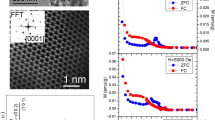Abstract
Gallium nitride powders and zinc oxide powders were each calcined with a few weight percent of copper oxide and/or magnesium oxide either in air or N2. Powder X-ray diffractometry, transmission electron microscopy, energy dispersive X-ray spectroscopy, and electron energy loss spectroscopy were performed in order to observe calcination induced structural effects on these wurtzite type semiconductors. We note that our earlier magnetic results on Cu doped GaN are qualitatively consistent with recent first principle calculations [Wu et al., Appl. Phys. Lett. 89 (2006) 62505].
Similar content being viewed by others

References
T. Dietl et al., Science 287 (2000) 1019 as well as T. Dietl and H. Ohno, Materials Today 9 (2006) 18.
P. Sharma et al., Nature Materials 2 (2003) 673.
L. Noice et al., Mater. Res. Soc. Symp. Proc. Vol. 891 (2005) 0891-EE10-10.1.
L. Noice et al., Mater. Res. Soc. Symp. Proc. Vol. 941 (2006) 0941-Q08-14.1.
P. Moeck et al., Proc. Mater. Sci. and Technol. (MS&T) 2006: Fundamentals and Characterization, Vol. 1 (2006) 517.
B. Seipel et al., J. Mater. Res. 22 (2007) 1396.
Employing the computer programs SIGMAL3 and SIGMAK3 (by R.F. Egerton, Electron energy-loss spectroscopy in the electron microscope, Plenum Press, 1996, pp. 485), the partial inelastic cross-section of the Cu L-excitation was calculated to amount to 0.016 pm2 (for a collection angle of 3 mrad and an energy window of 60 eV). Because the simulated partial inelastic cross-section of the O K and N K-excitations are by larger a factor 2.4 and 5.2 than the Cu-L cross section, we assume that a small amount of Cu (in oxidized states with partly filled 3d sub-shells) could be present in our samples without resulting in clearly distinguishable L2,3 “white lines” in the EELS.
These simulations employed the WebEMAPS software, developed by J.M. Zuo and J.C. Mabon, University of Illinois at Urbana – Champaign, and openly accessible at URL: http://emaps.mrl.uiuc.edu/.
S. Hovmöller, CRISP: crystallographic image processing on a personal computer, Ultramicroscopy 41 (1992) 121.
Author information
Authors and Affiliations
Rights and permissions
About this article
Cite this article
Moeck, P., Noice, L., Li, C. et al. Structural Effects of Transition Metal Oxide Calcinations on Wurtzite Type Semiconductors That are Ferromagnetic at Room Temperature. MRS Online Proceedings Library 999, 301 (2007). https://doi.org/10.1557/PROC-0999-K03-01
Received:
Accepted:
Published:
DOI: https://doi.org/10.1557/PROC-0999-K03-01



